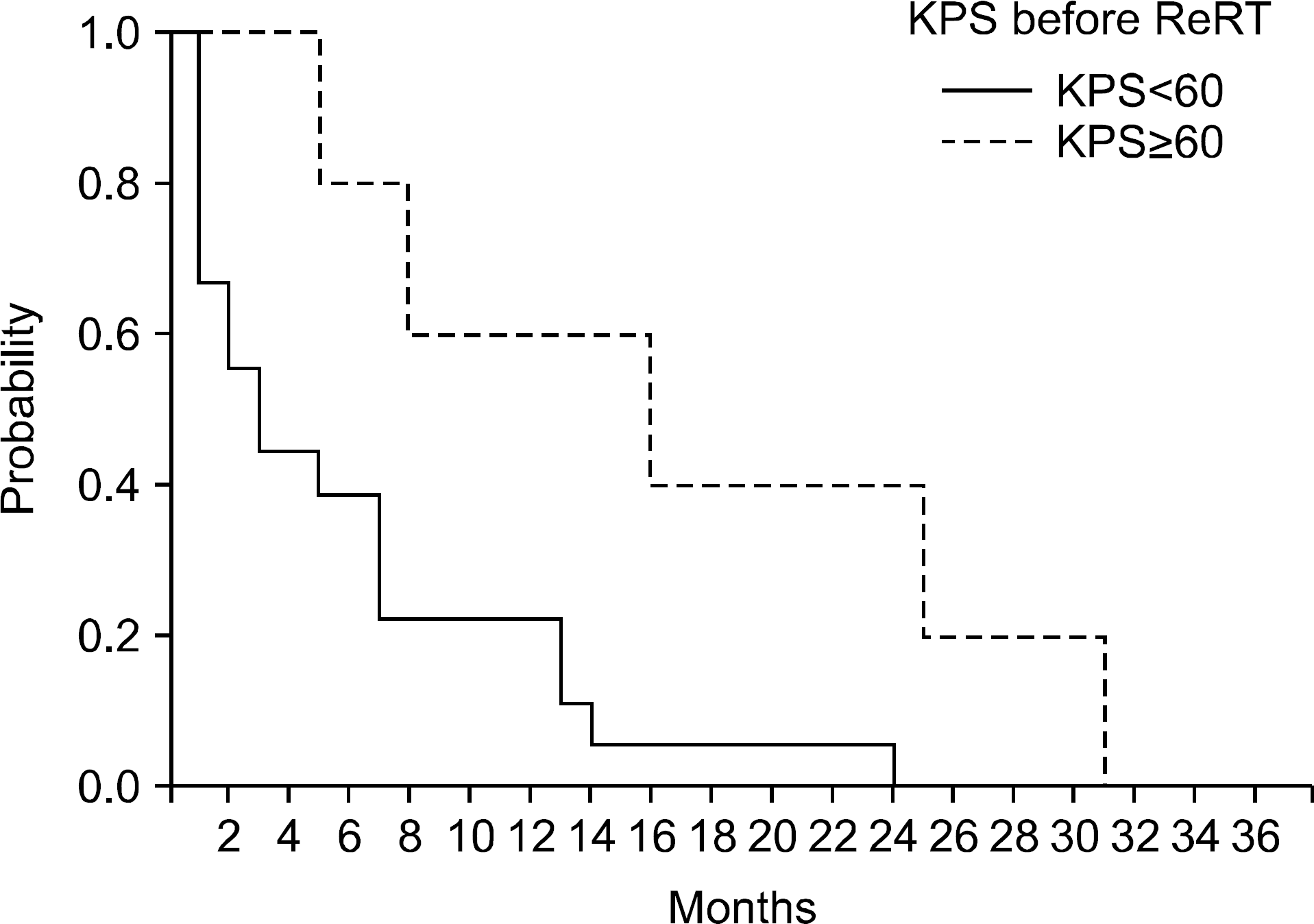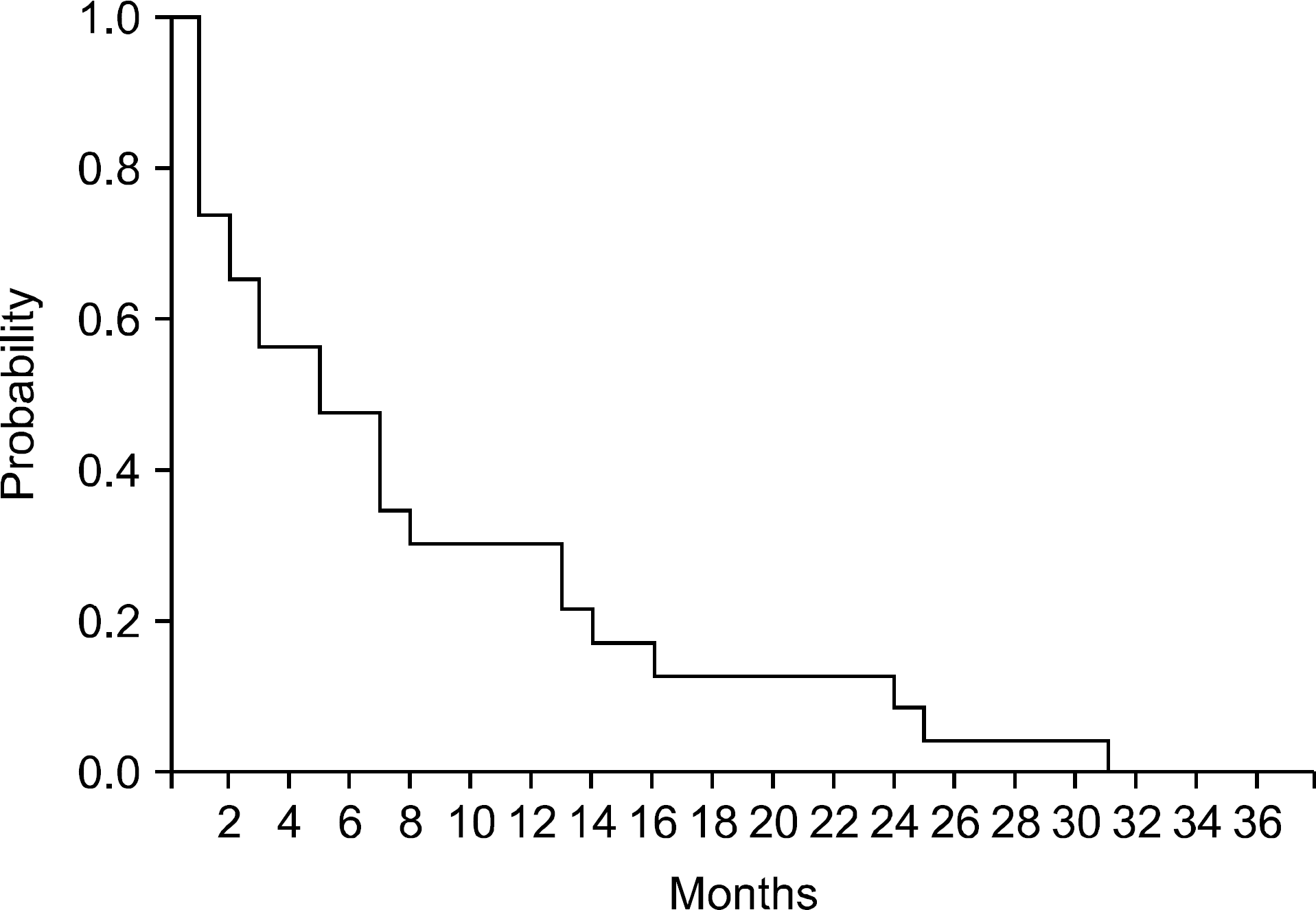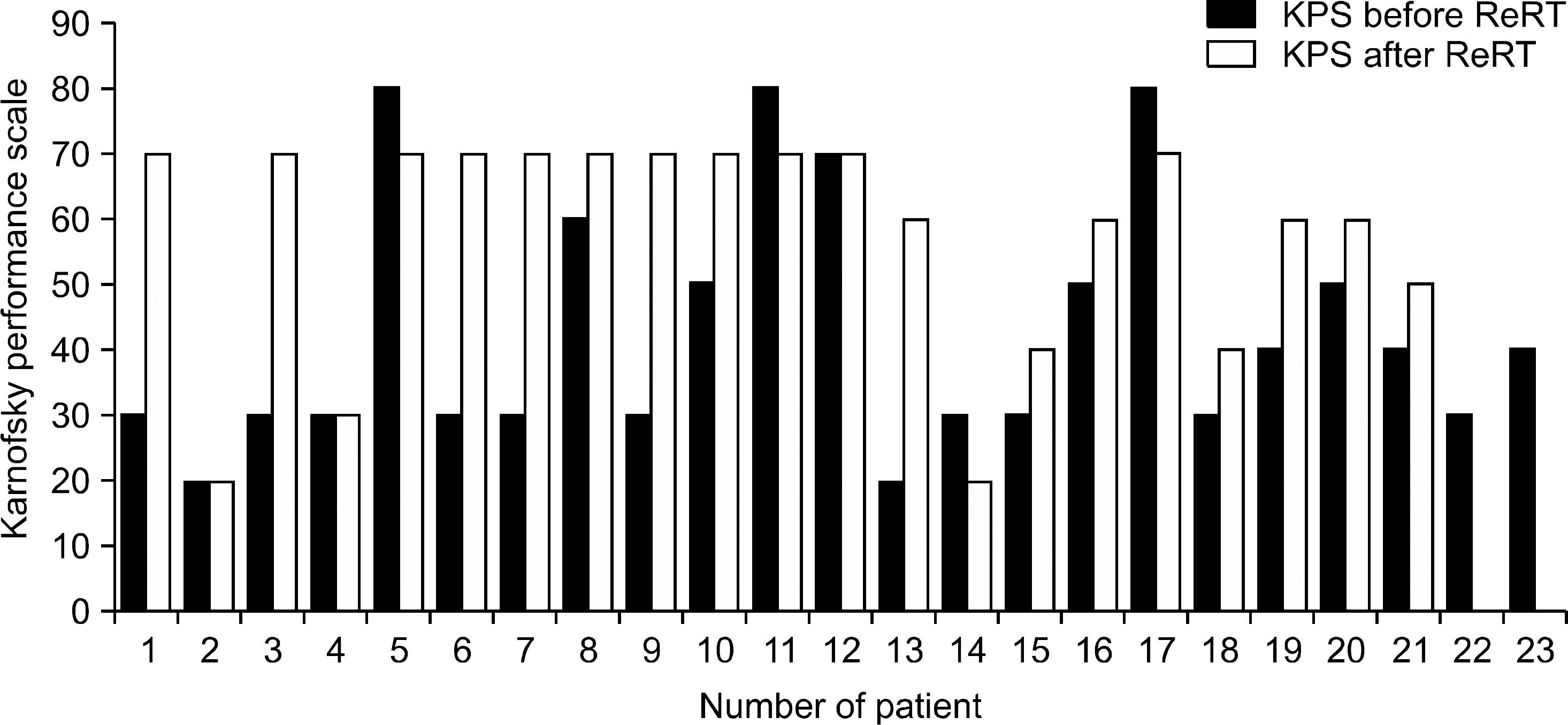Abstract
We retrospectively analyzed the outcomes in patients who underwent reirradiation for brain metastasis. Twenty-three patients with brain metastases who were initially treated with palliative brain radiotherapy and were retreated with a second course of brain RT between June 2008 and December 2012. WBRT, 3DCRT and SRS were used for brain metastasis. The median dose of the first course of WBRT was 30 Gy (range, 23.4∼30 Gy). The dose of the first course 3DCRT for lesion was 30 Gy in 3 Gy per fraction. The median dose of the first course of SRS was 16 Gy in 1 fraction (range, 12∼24 Gy). The median dose of the second course of WBRT was 27.5 (range, 12∼30 Gy). The median dose of the second course of 3DCRT for lesion was 30 Gy (range, 25∼30 Gy). The dose of the second course of SRS was 16 Gy in 1 fraction. The second course of WBRT was administered on radiographic disease progression with symptom in all patients. With median follow-up of 25 months, overall symptom resolution rates were 47.8%. Rate of palliative efficacy was 82.6% including stable disease. The median survival time after initiation of reirradiation was 3.2 months. Median value of KPS prior to reirradiation was 30. Median value of KPS after reirradiation was 60. Reirradiation of brain metastasis maybe feasible and effective in select patients with a good performance status KPS≥60 (: ECOG 0∼2) prior to reirradiation.
Go to : 
References
1. Nussbaum ES, Djalilian HR, Cho KH, Hall WA. Brain Metastases Histology, Multiplicity, Surgery, and Survival. Cancer. 1996; 78:1781–8.

2. Barani IJ, Larson DA, Berger MS. Future directions in treatment of brain metastases. Surg Neurol Int. 2013; 4:220–31.

3. Gravrilovic IT, Posner JB. Brain metastases: epidemiology and pathophysiology. J Neuro Oncol. 2005; 75:5–14.
4. Neider C, Spanne O, Mehta MP, Grosu AL, Geinitz H. Presentation, patterns of care, and survival in patients with brain metastases. Cancer. 2011; 117:2505–12.

5. Wong J, Hird A, Zhang L, et al. Symptoms and quality of life in cancer patients with brain metastases following palliative radiotherapy. Int J Radiat Oncol Biol Phys. 2009; 75:1125–31.

6. Minniti G, Scaringi C, Lanzetta G, et al. Whole brain reirradiation and concurrent temozolomide in patients with brain metastases. J Neurooncol. 2014; 118:329–34.

7. Ozgen Z, Atasoy BM, Kefeli AU, et al. The benefit of whole brain reirradiation in patients with multiple brain metastases. Radiat Oncol. 2013; 8:186.

8. Wong WW, Schild SE, Sawyer TE, Shaw EG. Analysis of outcome in patients reirradiated for brain metastases. Int J Radiat Oncol Biol Phys. 1996; 34:585–90.

9. Lucas JT, Colmer HG, White L, et al. Competing risk analysis of neurologic versus nonneurologic death in patients undergoing radiosurgical salvage after whole-brain radiation therapy failure: who actually dies of their brain metastases. Int J Radiat Oncol Biol Phys. 2015; 92:1008–15.
10. Yuan H, Gaber MW, Boyd K, et al. Effect of fractionated radiation on the brain vasculature in a murine model: blood-brain barrier permeability, astrocyte proliferation, and ultrastructural changes. Int J Radiat Oncol Biol Phys. 2006; 66:860–6.
11. Mayer R. Sminia P. Reirradiation tolerance of the human brain. Int J Radiat Oncol Biol Phys. 2008; 70:1350–60.
12. Son CH, Jimenez R, Niemierko A, et al. Outcome after whole brain reirradiation in patients with brain metastases. Int J Radiat Oncol Biol Phys. 2012; 82:e167–72.
13. Adkison JB, Tome W, Seo S, et al. Reirradiation of large-volume recurrent glioma with pulsed reduced-dose-rate radiotherapy. Int J Radiat Oncol Biol Phys. 2011; 79:835–41.

14. Maranzano E, Trippa F, Casale M, et al. Reirradiation of brain metastases with radiosurgery. Radiother Oncol. 2012; 102:192–7.

15. Olson AC, Wegner RE, Rwigema JCM, et al. Clinical outcomes of reirradiation of brain metastases from small cell lung cancer with Cyberknife stereotactic radiosurgery. J Cancer Res and Ther. 2012; 8:411–6.
16. Paulino AC, Mai WY, Chintagumpala M, Taher A, The BS. Radiation-induced malignant gliomas: is there a role for reirradiation? Int J Radiat Oncol Biol Phys. 2008; 71:1381–7.

17. Shaw E, Scott C, Souhami L, et al. Single dose radiosurgical treatment of recurrent previously irradiated primary brain tumors and brain metastases: Final report of RTOG protocol 90–05. Int J Radiat Oncol Biol Phys. 2000; 47:291–8.

18. Veninga T, Langendijk HA, Slotman BJ, et al. Reirradiation of primary brain tumours: survival, clinical response and prognostic factors. Radiother Oncol. 2011; 59:127–37.

19. E. Bezjak A, Yi QL, et al. Value of whole brain reirradiation for brain metastases – single centre experience. Clin Oncol. 2007; 19:532–8.
Go to : 
 | Fig. 2.Overall survival after reirradiation by KPS. Median overall survival for patients with KPS≥60 were 16 months, and 3 months for patient with KPS<60. |
Table 1.
Clinical characteristics of patients.




 PDF
PDF ePub
ePub Citation
Citation Print
Print




 XML Download
XML Download